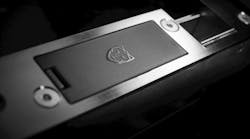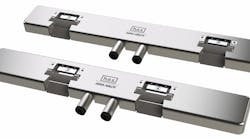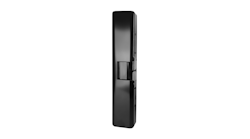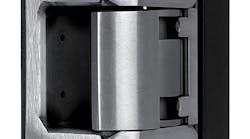If the idea of wiring up an electric strike for a customer makes your palms sweat, ASSA ABLOY has a solution for you.
The new HES ES100 is a battery-powered electric strike that ASSA ABLOY is aiming at retrofits where electronic access control (EAC) is desired but isn’t already in place. Another target: locksmiths who lack wiring acumen.
“It really removes the most painful part around the install, which is the last 10–15 feet of wire around the door,” says Matt Branson, product manager of ASSA ABLOY Electronic Security Hardware. “You’re not always able to do it as a locksmith. Sometimes you have to hire an electrician to run wires, so it really just simplifies the process for everybody who’s going to be installing these.”
Larry Schwalb owns Houdini Lock & Safe, a three-location locksmithing business in and around Philadelphia. He attended an ASSA ABLOY tutorial on the ES100 and agrees that the product should be a boon to locksmiths.
“The beautiful thing about wireless electric release is that it cuts down on a lot of issues having to do with where the power is going to come from when you have to run an electric release and pull it through a door frame,” he says. “A lot of times we’re dealing with mortar and concrete and stone, and that can be difficult.”
The fail-secure ES100 strike has the features of an HES 1500 (latchbolt) or 1600 series (latch and deadbolt) strike and connects with an included Securitron R100 reader through ASSA ABLOY’s Aperio wireless technology. The ES100 can operate as a stand-alone solution or tie into an existing EAC system, thus providing audit trails, through an optional Aperio hub.
The strike features a variety of interchangeable faceplates, which makes it compatible with nearly all cylindrical and mortise locksets, including those from BEST, Marks USA and PDQ.
The Installation
Although it’s called a wireless strike, installing the ES100 requires connecting a couple wires between the strike and reader and any latch- or door-position-monitoring option — but not hardwiring into the power grid. Instead, power is provided by two AA batteries in the reader. ASSA ABLOY says the ES100 is good for 45,000 cycles — 60-70 per day, Branson estimates — or more than 2 years under normal use if AA LR6 lithium-ion batteries are used.
Replacing the batteries is as simple as removing a screw on the reader and then the reader cover. A micro-USB port on the reader provides a 5-volt emergency power source as well as local firmware updates.
The ES100 comes as a pre-paired kit that’s configured in the factory or as field-configurable components. The former is a notable development from an installer’s perspective, because it means the installer doesn’t have to be Aperio-certified to install the strike, as they do with many other Aperio products.
It’s also good from a customer’s standpoint, Branson says. “It allows customers who may not be familiar with Aperio to get their feet wet with it and try it out on a single opening.”
(The advantage of Aperio certification is that the solution becomes customizable, and a security pro could connect multiple openings [up to 64] to a single hub.)
Another advantage, Schwalb notes, is that because it’s an ASSA ABLOY product, the ES100 handles all of the credential technology created by ASSA ABLOY company HID. In fact, the ES100 accepts a variety of low-frequency (125 kilohertz), high-frequency (13.56 megahertz) and Bluetooth and near field communications credentials, including iCLASS, MIFARE and DESFire cards and fobs and mobile credentials.
The ES100 has been a work in progress more or less for three years, Branson says. The biggest difficulty in making the product a reality was in trying to figure out how to deliver enough power to activate the strike, because electric strikes typically use a solenoid to release the latch, and solenoids require constant (read: wired) power. The solution was the introduction of a low-power motor, which ASSA ABLOY had developed as part of its EcoFlex platform.
“Once we were able to get the motorized aspect of it down, then it was more [determining] what’s the amount of batteries that seems appropriate for the driving of a specific motor?” Branson says.
But there was more to it than just putting in a motor, he adds. ASSA ABLOY also wanted the ES100 to have the same ratings that the 1500 and 1600 series strikes have. Those include a UL 10C 3-hour fire rating and ANSI 250.13 windstorm resistance.
“There’s a really small space inside that strike body, so developing all the functionality and maintaining the same ratings — that was what was most difficult,” Branson says.
Applications
The strike and reader are rated for indoor use or in-swing exterior doors only. Branson says the ES100 is aimed at offices, K-12 facilities and universities, and hospitals, and Schwalb says he believes it’s particularly suited to interior doors.
“Exterior doors are pretty much the domain of other types of devices, exit bars for the hardware and other types of electric releases to release those, but for the interior doors, I think this is a fantastic opportunity,” he says.
One area that, in his opinion, wouldn’t be suited for the ES100 is when continuous duty is required, because it could drain the batteries quickly. Aside from that, Schwalb says he’s looking forward to getting a test model and putting it through its paces.
“All in all, this is quite a revolution in our industry,” he says.
And it might just be the beginning. ASSA ABLOY, of course, offers far more models of strikes under the HES brand than just the 1500 and 1600 — 18 series, in fact, not including the ES100. Now that the wireless technology has been figured out for the company’s biggest selling series of strikes, any thought that ASSA ABLOY will bring it to other models?
“One hundred percent,” Branson says. “It’s kind of like a platform, so imagine connecting our R100 reader to a surface-mount rim electric strike or a no-cut 8000 series electric strike for cylindricals. It’s definitely at the forefront of our minds. All I can say with that one is ‘stay tuned.’”
Features:
- Nonhanded
- Strike body depths: 1-3/8 in. 1500, 1-5/8 in. 1600
- Frame applications: hollow metal, wood
- Static strength: 1,500 lbs.
- Dynamic strength: 70 ft-lbs.
- Integrated locked state and tamper monitoring
- Field-adjustable integrated shim for changing door conditions
- Stainless steel construction (strike)
- Bicolor LED status indicators, red/amber or green/amber (reader)
- Low-battery monitoring and alert
- Wireless AES 128-bit encryption
- Certifications: UL 294, UL 1034, NFPA-252, California Fire Marshal, Florida Building Code
- Finishes: 605, 606, 612, 613E, 629, 630, Black Suede Powder
More info: www.assaabloyesh.com






